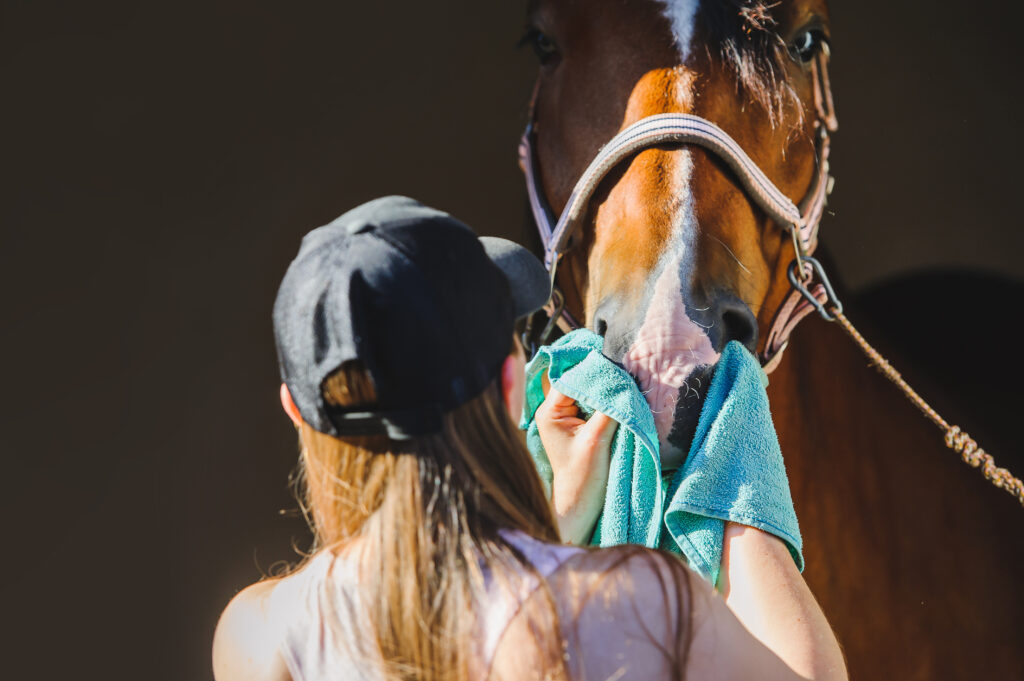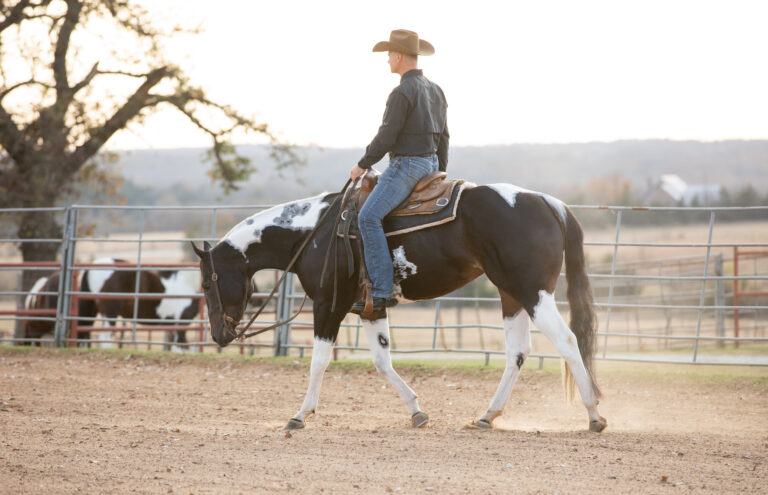
The bad news: Equine herpesvirus-1 (EHV-1) is everywhere, and disease incidents are reported with relative frequency. The possibility of an outbreak is a scary thought, especially with the 2021 Valencia and 2022 California outbreaks still in recent memory. But the good news? EHV-1 is everywhere, and most horses aren’t getting sick, even after going to horse shows.
Katie Flynn, BVMS, Equine Health and Biosecurity Veterinarian for the United States Equestrian Federation, reminds us: “EHV is in the environment, at their home barn, at shows, and it’s latent in each horse. Herpes is for life.”
Indeed, Nicola Pusterla, DVM, PhD, DACVIM, an associate professor of equine internal medicine at the University of California, Davis, School of Veterinary Medicine, chief of large animal medicine, and section head of equine medicine and dentistry, and colleagues conducted a study in 2022 to determine the frequency of respiratory viruses, including EHV-1, in nasal and stall swabs from healthy horses attending a sport horse show. Although none of the nasal swabs were positive for EHV-1, 3.3% of the stall swabs were positive, highlighting the role of “subclinical or silent shedders in introducing respiratory pathogens to shows and their role in environmental contamination.”
“Keep in mind that the rate of silent EHV-1 shedding depends mostly on the age and use of tested horses as well as the time of the year,” Pusterla says.
In Flynn’s opinion, the equine industry doesn’t need to panic at the prospect of an EHV outbreak; instead, she recommends putting that energy toward awareness of potential risks. She believes one of the main ways we can minimize the chances of an EHV-1 outbreak is through twice-daily temperature checks and reporting of fevers at all horse shows.
The EHV-1 Panic
“The hysteria we see with EHV-1 is that on rare occasion, the virus can cause the often-fatal equine herpesvirus myeloencephalopathy (EHM),” Pusterla explains. “Everyone is worried about this potential complication of EHV-1. But what veterinarians and owners need to appreciate is that by the time you have a horse on the ground with neurological signs, you’re at least 10 days into the disease.”
In general, EHM is very rare. So rare, in fact, that owners—and perhaps even some veterinarians—don’t think their horses will ever become exposed or infected. This mentality explains (at least in part) the general laxity in basic biosecurity, particularly the lack of monitoring horses’ temperatures daily.
“But as soon as a horse tests positive for EHV-1 at a show, it’s literal hysteria,” says Pusterla. “People take their horses home without implementing any biosecurity measures, and the disease spreads to the resident population at home. And what do we see? Mortality and morbidity, especially in the elderly horses who we know are at an increased risk of disease.”
Flynn says respiratory disease and EHV-1 are far more commonly diagnosed back on resident farms than at weekend horse shows because the incubation period is seven to 10 days.
Preparing for EHV-1 Exposure
We know anytime horses commingle at shows, they’re at risk of acquiring not only EHV-1 but also other respiratory pathogens, including equine influenza virus (EIV), Streptococcus equi subspecies equi, equine rhinitis A/B viruses (ERAV/ERBV), and equine herpesvirus-4.
Flynn says ways veterinarians can work with their clients to keep horses healthy at shows include:
- Ensuring the horse is up to date on vaccinations, including EHV-1 and EIV, within six months prior to showing.
- Completing a declaration of health stating the horse has not had a temperature above 101.5 degrees F in the previous three days and has no signs of illness.
- Directing owners to take rectal temperatures twice daily while on the show grounds and voluntarily reporting any spike in fever.
Flynn also advises being cognizant of how and when respiratory viruses like EHV-1 can spread at the show. For example, we know nose-to-nose contact is one mode of transmission.
“One of my biggest pet peeves is when someone wipes multiple horses’ noses right before they go into the show ring with the same rag,” she says. “Why are we sharing these? We don’t share used tissues.”
And depending on the discipline and venue, some horses are tied very closely to one another outside the arena, permitting nose-to-nose contact.
“Most of the time, however, EHV-1 is spread by indirect transmission,” says Pusterla. “Equipment, tack, farriers, veterinarians, groomers, braiders, and other humans traveling from one horse to the next with limited cleaning between.”
Facing a Fever

In addition to taking horses’ temperatures twice daily, owners must be prepared and committed to actually report any fever above 101.5 F to show management and the competition veterinarian.
Temperature-taking, Flynn says, is a major means of controlling the spread of respiratory disease, particularly EHV-1, at shows, and this is where she says she meets the most pushback.
“If the owners would just recognize the first spike in temperature and remove the horse from the general population, we would be much farther ahead in preventing disease transmission,” Flynn says.
Primary equine practitioners can help improve biosecurity at shows by educating clients about the importance of taking daily temperatures and knowing a horse’s baseline temperature rather than relying on how the horse looks or behaves as an indicator of disease. In addition to rectal temperatures, various percutaneous thermal sensing microchips are available that might be easier for owners to use, facilitating the temperature-taking and habit-changing processes.
Pusterla further reminds primary practitioners that we shouldn’t be married to that threshold of 101.5 F. What owners really need to know is each individual horse’s baseline temperature—their normal, reproducible nonexercised temperature. And if it becomes elevated to a fever, call the veterinarian, he says.
“Even if it’s a temporary fever, call the veterinarian,” Pusterla asserts. “If the fever goes away, owners still have an obligation to isolate that horse for seven to 14 days because we don’t know what the fever was from. We can’t just assume it was a noncontagious, self-limiting condition.”
This holds particularly true for horses on non-steroidal anti-inflammatory drugs. It’s ill-advised to simply go by the threshold of 101.5. Instead, we must look at the temperature trend for that horse.
“Temperature is a very reliable indicator of infection, and it is important for veterinarians to educate their clients on this fact,” says Pusterla.
Poise & Grace in the EHV Space

In the face of a fever, immediately segregate horses and test for respiratory pathogens. But recall that shedding of the EHV-1 virus might not occur in synchrony with the fever.
“According to Merck Biosurveillance data, only about one-third out of 100 horses with a fever and respiratory signs will have a detectable pathogen, leaving two-thirds of index cases negative,” Pusterla explains. “But they could still be index cases; we’ve just either tested too early or too late. We then need to make clinical decisions about how to proceed with that horse based on both the PCR results and the horse’s clinical condition.”
At the Desert International Horse Park in Thermal, California, home to 2,100-2,800 horses per day during show season, Pusterla says logging temperatures twice daily is expected from all owners. In cases of fever, horses are moved to a holding barn where a point-of-care PCR test provides immediate EHV-1 results. Even if test results are negative, the horse is not released. Instead, veterinarians monitor the horse closely and retest 24 hours later in case the first test was performed prior to viral shedding. Then, if positive, the horse is isolated or removed from the premises or returned to its stall if negative.
“Failing to take twice-daily temperatures or electing to not report a fever regardless of the type or size of show is irresponsible,” says Flynn. “Protecting horse health on the competition grounds is everyone’s responsibility. Ensuring only healthy horses compete ensures healthy competition. Failure to do so puts other horses at risk and the show at risk for being canceled or quarantined.”
Being prepared when returning from a horse show is equally important as the preparation and precautions at the show.
“In a perfect world, every horse that comes home should be isolated for 21 days,” advises Pusterla. “Why would we take all these precautions at the show, then stop taking them at home?”
Testing for Respiratory Pathogens
Before PCR, testing for respiratory pathogens wasn’t popular, largely because the turnaround time was long. With PCR techniques, however, we have rapid, accurate, and widely available testing capabilities, making it much more appealing.
Testing might be available to some clients through the Merck Animal Health Equine Respiratory Biosurveillance Program, a program for clinics using Merck Animal Health equine vaccines. If participating veterinarians have a horse with clinical signs of nasal discharge, cough, or lethargy and a temperature of 101.5 F or higher, they can submit a nasal swab and purple top blood tube to Pusterla’s laboratory at UC Davis. The lab tests for EHV-1, EHV-4, EIV, Streptococcus equi subspecies equi, and ERAV/ERBV and provides results within 24 hours. Veterinarians can also submit samples to a commercial veterinary diagnostic laboratory.
Some owners are hesitant to test for various reasons, including cost constraints or the downside of having to skip a show or be quarantined at home should the test be positive for EHV-1. Further, some owners have the impression that treatment is simply supportive regardless of the underlying cause, begging the question, “Why bother?”
“Treatment can be generic for some respiratory pathogens, but when dealing with EHV-1, owners of horses in high-risk populations may not want to take the chance/risk the spread of disease and elect to actively treat with antiherpetic drugs. A lot of people will do this these days,” Pusterla says.
Respiratory Research
Information from samples submitted through the Biosurveillance Program provides the horse industry with an understanding of the prevalence and epidemiology of respiratory pathogens and helps monitor circulating strains throughout the country. Using this data, Pusterla has published several studies on the detection and prevalence of common respiratory pathogens in equids. He has also conducted extensive research on respiratory pathogens, specifically environmental detection of EHV-1. He is currently conducting a pilot study on testing horse trailers for EHV-1.
Further, Lutz Goehring, DVM, DACVIM, DECEIM, professor and Lucille Wright Markey Endowed Chair in Equine Infectious Diseases at the University of Kentucky’s Maxwell H. Gluck Equine Research Center, is conducting a study on developing and validating an airborne pathogen surveillance method to detect EHV-1 early during equestrian events. He anticipates presenting this data at the ACVIM Forum in Louisville, Kentucky, in June 2025.
“I believe that the most relevant point from the various studies is that silent shedding happens and is one of the ways EHV-1 builds up in the environment and can spill over to susceptible horses,” says Pusterla. “Because the environment takes the burden of respiratory pathogens, and such viruses/bacteria can survive in the stall for a few days, it is important to impose proper biosecurity and hygiene at home and any time horses go so shows.”
Concluding Thoughts on EHV-1
EHV-1 is ubiquitous and can resurge in almost any horse at any time. “EHV-1 is an occupational hazard … it’s part of horse ownership, and this means that we sometimes have to skip going to shows if the horse has a fever or leave a show early without competing,” Pusterla says.
Flynn, who works with show management to proactively protect horses from respiratory illness, adds, “I get a lot of pushback from people who don’t think it will happen to them. If we can just recognize the first spike in temperature, immediately remove the horse from the population, and not allow it to compete, we can stop the disease in its tracks and protect all horses on the grounds.”
This article is brought to you by Merck Animal Health.
Related Reading
- EHV-1: Current Vaccines, Challenges, & Future Directions
- Kester News Hour Hot Topics: Melanoma, EHV-1, and Lyme Disease
- Horse Owner Knowledge and Use of Biosecurity
Stay in the know! Sign up for EquiManagement’s FREE weekly newsletters to get the latest equine research, disease alerts, and vet practice updates delivered straight to your inbox.

![[Aggregator] Downloaded image for imported item #18965](https://s3.amazonaws.com/wp-s3-equimanagement.com/wp-content/uploads/2025/11/26161444/EDCC-Unbranded-4-scaled-2-768x491.jpeg)

![[Aggregator] Downloaded image for imported item #18782](https://s3.amazonaws.com/wp-s3-equimanagement.com/wp-content/uploads/2025/11/03125751/EDCC-Unbranded-13-scaled-1-768x512.jpeg)
